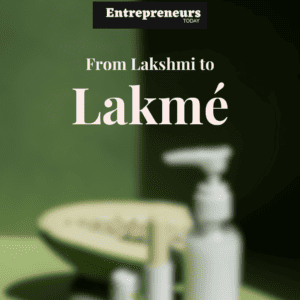Lakmé, India’s first cosmetics brand, was founded by J.R.D. Tata to empower women with high-quality beauty products. Its journey from inception to market dominance has been a remarkable tale of innovation and customer-centricity. Today, Lakmé stands as a symbol of Indian beauty and elegance, with a diverse range of products catering to its widespread consumer base.

But when did it all begin?
Pandit Jawaharlal Nehru, India’s first Prime Minister, played a crucial role in the launch of Lakmé, India’s premium makeup brand. Concerned about the outflow of money due to imported cosmetics post-independence, Nehru convinced his friend J.R.D. Tata to establish a cosmetics company in India. Thus, in 1952, Lakmé was born, providing quality products tailored for Indian skin and climate.
The first cosmetic company
Lakmé, the first cosmetic company established in independent India, marked the Tata group’s entry into the cosmetics industry during J.R.D. Tata’s chairmanship. It was set up as a subsidiary of Tata Oil Mills Company (TOMCO). In 1953, TOMCO seized the opportunity in the market’s absence of indigenous cosmetics and launched Lakmé in collaboration with two prestigious French firms, Robert Piguet and Renoir. The collaboration emphasized a ‘Make in India’ mission, with foreign partners sharing their perfume know-how for a fee.
Lakmé’s Name and Inspiration
Lakmé’s name derives from the French word for Lakshmi, embodying Indian and French influences. It also draws inspiration from a popular Parisian opera and symbolizes the Hindu goddess of wealth and beauty.
In 1961, Simone Tata, Naval H. Tata’s wife, assumed the role of managing director, infusing Lakmé with her aesthetic sense and business expertise. Her impactful leadership led the brand to iconic status, and she later became the chairperson in 1982.
Gaining traction
With a robust network of dealers, sales offices, and well-planned marketing strategies, Lakmé established itself strongly in urban markets across India. Over the years, it gained popularity and became a key player in the Indian cosmetics market.
In 1993, TOMCO merged with Hindustan Unilever in a strategic move. Subsequently, Lakmé entered a joint venture with Hindustan Unilever in 1996. Eventually, in 1998, Lakmé sold its brands to Hindustan Unilever, yet it continues to lead the cosmetics market in India, setting new standards and commanding a significant market share.
Lakmé’s cutting-edge research lab drove continuous innovation, expanding its portfolio to meet evolving consumer preferences and broader market demands. Rigorous quality control ensured high-grade products meeting international standards, solidifying Lakmé’s position among the top players in the industry.
In 1980, Lakmé initiated a chain of branded beauty salons, providing women with a wide array of beauty treatments by qualified beauticians. A beauty school followed, offering a 6-month intensive course that combined theory and practical training, leading to a diploma upon completion. Additionally, trained beauticians traveled across the country, conducting lectures, make-up demonstrations, and expert beauty advice.
Over the years, Lakmé emerged as a prominent name in the Indian cosmetics market. In 1993, TOMCO merged with Hindustan Unilever, leading to a 50:50 joint venture between Lakmé and Hindustan Unilever in 1996. Later, in 1998, Lakmé divested its 50 percent stake in the joint venture and sold its brands to Hindustan Unilever. Despite these changes, Lakmé continues to lead the cosmetics market in India, setting new standards and commanding a significant market share.







